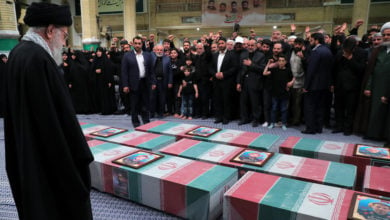Feb. 11 marks 30 years since a mass movement of millions of Iranians overthrew the tyrannical rule of the Shah, ending 25 years of neocolonial domination by the United States.
|
As in much of the Middle East, U.S. intervention in Iran is closely connected to the control of its vital resource, oil. In the first half of the 20th century, all of Iran’s oil was stolen by the Anglo-Iranian Oil Company, the British company that would later become British Petroleum.
The 1906 bourgeois-democratic revolution known as the Constitutional Revolution had established a parliamentary system in Iran. In April 1951, Mohammad Mossadegh, a nationalist leader, was elected prime minister. Just the previous month, in response to a mass movement, the Majles (parliament) voted to nationalize the oil.
Appalled by the idea of Iran’s oil belonging to Iranians, Britain called for a worldwide embargo of Iran’s oil, which the U.S. government supported. For his efforts to exercise independence and prevent the plunder of Iran’s natural resources, Mossadegh was demonized by the imperialist media. Time Magazine called Mossadegh a “mad man.”
The MI6—the British intelligence agency—started plotting for the overthrow of the regime. In response, Mossadegh shut down the British embassy. At that point, the U.S. embassy became the leading force in the drive for regime change.
In August 1953, Mossadegh’s government was overthrown by a coup. With the coup, the Shah was put on the throne as a tyrant with absolute power. The parliamentary system was to be no more.
This was not simply a CIA-supported coup; it was a CIA coup. It was the first large-scale success of the CIA, at that time still in its infancy. The CIA developed a comprehensive plan named Operation AJAX, organizing right-wing generals and financing groups of criminal elements to oust Mossadegh.
In December 1977, U.S. President Carter visited Iran. Reassuring the Shah of continued support for his regime, Carter called Iran “an island of stability.” At that time, Iranians lived under the boots of the SAVAK, the CIA-trained secret service that, according to Amnesty International had, “the worst human rights record on the planet.”
But Carter’s island of stability was soon to be the scene of a remarkable people’s revolution. In February 1979, after months of militant mass protests, the U.S. client regime was overthrown.
The class character of the Islamic Republic
The Iranian revolution was not led by the most progressive forces. The left and the secular nationalist forces had been crushed by the U.S. client regime, leaving a grouping of Islamic nationalists with socially reactionary views to take the leadership of the revolution.
While solidly anti-imperialist in its orientation, the Islamic Republic has also been staunchly anti-communist. This is evident from the bloody campaign of repression carried out against leftist forces, particularly in the first decade of the revolution.
The Islamic Republic represents the capitalist class, but it is rooted in the nationalist sectors of that class. Unlike the comprador sectors of the capitalist class, which are content in selling out the country to the highest bidder, the nationalists seek to assert control over the country’s resources so that they can exploit them to their own ends.
This gives the Islamic Republic a dual character. Insofar as it oppresses the working class, it is a reactionary force. But insofar as it defends Iran’s independence from imperialist plunder, it is a progressive force.
In oppressed countries, whose development has historically been stunted by imperialist penetration, independent development can result in gains for all classes even under capitalism. Iran is a good illustration of this potential. Iraq was another—which was a major reason behind the 2003 invasion.
The business media frequently reports on the real economic problems that Iran faces, mainly inflation and unemployment, but the revolution has brought substantial development. The Feb. 2 launch of an Iranian-made satellite using an Iranian-made rocket symbolizes this rapid progress.
According to the IMF, Iran has now become the world’s 21st largest economy, with a GDP of more than $600 billion. The economy grew at a rate of 4.5 percent in 2005, 5.3 percent in 2006 and 5 percent in 2007.
The range and breadth of the growth of Iran’s domestic industry and technology has been quite wide. Iran’s auto industry is manufacturing nearly 1 million vehicles annually, by far the largest vehicle output in the Middle East. The country’s major cities are connected by an impressive series of highways. Major infrastructure projects have now provided electricity, running water and heating gas to all but the most remote areas of the country.
Washington and Tehran
The Iranian revolution changed the balance of power in the region. Up until then, Iran was a reliable and loyal client state, policing the region for Washington and playing a similar role to Israel’s.
In the 1970s, the Iranian regime helped the kingdom of Oman crush the Dhofar liberation movement led by the leftist Popular Front for the Liberation of Oman. At the time, U.S. friendly dictator Qaboos bin Said ruled Oman. A revolution there might have inspired others throughout the Arab countries, mostly under U.S. client regimes. With the help of Iran’s military, armed with the best and latest U.S. weaponry, the revolution in Oman was defeated.
Since the revolution, the U.S. ruling class has been unwilling to relinquish its plans for retaking Iran. This is why regime change has effectively been U.S. policy on Iran since the Shah’s overthrow.
Over the eight years of the Iran-Iraq war, which cost nearly 1 million lives on both sides, the U.S. supplied Iraq with financial, technological and military assistance in a war it had actively promoted. But the U.S. at times also supplied Iran with weapons, reflecting a policy that was not seeking a victory by either side, but the destruction of both sides. Despite differences in their political character, both Iran and Iraq had independent regimes that were undesirable in Washington’s eyes. If they could not be overthrown, both sides had to be weakened as much as possible.
During the eight years of the Bush administration, particularly after Sept. 11, 2001, a U.S. bombing or invasion of Iran was a constant threat. After the invasion of Afghanistan and Iraq, Iran’s neighbors to the east and west respectively, the danger of a U.S. attack turned into an imminent possibility.
Following the election of Mahmoud Ahmadinejad as Iran’s president in the summer of 2005, the demonization campaign against Iran reached new heights. Ahmadinejad is not shy about defending Iran’s independence and expressing opposition to imperialist designs for the region.
The anti-Iran campaign has been multi-faceted, from whipping up hysteria around Iran’s nuclear energy program to blaming Iran for every U.S. defeat in Iraq and Afghanistan, to holding Iran responsible for Israel’s defeat in Lebanon in the summer of 2006.
The demonization effort has also contained strong pseudo-democratic components, attacking Iran for its human rights record and its record on democracy and women’s rights. To the people of Iran, having witnessed the bloody end of Iran’s democracy in the 1953 CIA coup, the U.S. government’s ostentatious concern for democracy is particularly insulting.
A significant grouping in the U.S. ruling class, headed by former Vice President Dick Cheney, advocated a military campaign against Iran. But Cheney and his cohorts failed to convince the U.S. ruling establishment that the benefits of bombing Iran would outweigh the potential risks for U.S. imperialism in the region.
New U.S. Policy?
With the end of the Bush administration, the imminent danger of a U.S. military attack on Iran has subsided for the time being. This is not to say, however, that regime change will cease to be the ultimate goal.
The Bush administration pursued regime change in a variety of ways. Among them were funding “pro-democracy” opposition forces, fomenting ethnic violence by organizing and funding terrorist groups such as Jondollah, and attempting to strangle Iran economically through extensive sanctions. The anti-Iran offensive is likely to continue, and possibly intensify, on all of these fronts under the Obama administration.
The fact that President Obama is less likely to bomb Iran should not be confused with a benign policy. It remains to be seen whether the Obama presidency will signal a significant change in Washington’s orientation toward Iran and the rest of the Middle East.
To the extent that there are changes, however, they will be at the tactical level. For over a half a century, U.S. policy has pursued the central objective of controlling the resources and the markets of the Middle East. This policy has persisted through Democratic and Republican administrations alike. As the chief executive of the U.S. ruling class, Obama will pursue the same central objective, whether through softer or harder tactics.
Many liberal and even “left” forces in the U.S. have buckled under the pressure of the anti-Iran propaganda and joined the demonization campaign against Iran. However, the task of U.S. revolutionaries and progressives is not to back Washington’s efforts to bring “democratic change” to countries in the crosshairs of imperialism. The U.S. working class has nothing to gain from the adventures of the ruling class in expanding its empire. The primary responsibility of revolutionaries and progressives is to fight against our own ruling class, the common enemy of the U.S. working class, oppressed people and independent states around the world.
U.S. hands off Iran!







